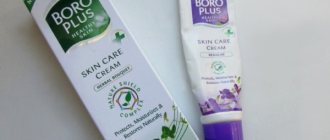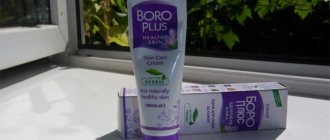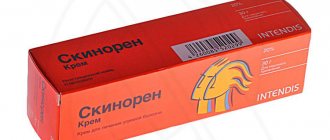Pharmacological properties of the drug Metrogyl gel
Metronidazole (1-(β-hydroxyethyl)-2-methyl-5-nitroimidazole) is an effective antibacterial and antiprotozoal agent from the group of nitroimidazole derivatives. Active against Trichomonas vaginalis, Entamoeba histolytica and Giardia intestinalis , as well as against obligate anaerobes - Bacteroides spp . ( B. fragilis, B. distansonis, B. thetaiotaomicron, B. vulgatus), Fusobacterium spp., Clostridium spp., Peptostreptococcus spp., Peptococcus spp. Inactive against aerobic microorganisms. The mechanism of action of Metrogyl is due to the biochemical reduction of the 5-nitro group of metronidazole by intracellular transport proteins of anaerobic microorganisms and protozoa. The reduced 5-nitro group of metronidazole interacts with the DNA of microorganisms, leading to their death. In the presence of mixed flora (aerobic and anaerobic bacteria), metronidazole acts synergistically with antibiotics active against aerobic microorganisms. Improvement usually occurs within 9 days of treatment.
Metrogyl gel for external use 30g
Compound
Active substance: metronidazole 10 mg.
Excipients: methyl parahydroxybenzoate, propyl parahydroxybenzoate, carbomer 940, disodium edetate, sodium hydroxide, propylene glycol, purified water.
Pharmacokinetics
Absorption is minimal; after external use of the gel, only trace amounts of the drug are found in the blood serum. Absorbed metronidazole passes through the placenta and blood-brain barrier. Cmax in the blood - up to 66 ng/ml (when applying 1 g of gel, equivalent to 7.5 mg of metronidazole).
Indications for use
- Rosacea (including post-steroid acne);
- acne vulgaris;
- oily seborrhea, seborrheic dermatitis;
- trophic ulcers of the lower extremities (against the background of varicose veins, diabetes mellitus);
- poorly healing wounds;
- bedsores;
- hemorrhoids, anal fissures.
Contraindications
Hypersensitivity to the components of the drug.
Directions for use and doses
For external use. The gel is applied to previously cleansed affected areas of the skin in a thin layer 2 times a day, morning and evening, for 3-9 weeks.
The duration of treatment is 3-4 months, the therapeutic effect is usually observed after 3 weeks of treatment.
Storage conditions
Store at a temperature not exceeding 30°C, out of the reach of children. Do not freeze.
Best before date
3 years. Do not use after the expiration date stated on the packaging.
special instructions
Avoid contact with eyes. If the gel gets into your eyes, rinse them immediately with plenty of water.
Description
Antiprotozoal drug with antibacterial activity for external use.
Pharmacodynamics
Metronidazole is a synthetic broad-spectrum antimicrobial and antiprotozoal agent from the group of imidazoles. Active against anaerobes (Bacteroides spp., Fusobacterium spp., Mobiluncus spp., Peptococcus spp., Peptostreptococcus spp., Clostridium spp., Eubacterium spp., Bacteroides fragilis, Prevotella spp.) and protozoa (Trichomonas vaginalis, Giardia intestinalis, Entamoeba histolytica).
When applied topically, it has an anti-acne effect, the mechanism of which is precisely unknown (not related to the effect on the Demodex folliculorum mite, found in hair follicles and the secretion of the sebaceous glands, and any effect on the production of this secretion).
Metronidazole for external use may have antioxidant activity. It has been found that it significantly reduces the production of active oxygen, hydroxyl radicals and hydrogen peroxide by neutrophils, which are potential oxidants that can cause tissue damage at the site of inflammation. Metronidazole for external use is not effective against telangiectasias noted with rosacea.
Side effects
When the gel is applied topically, the concentration of metronidazole in the blood is very low, so the risk of systemic side effects is low.
Rarely, allergic reactions (urticaria, skin rash) may occur; hyperemia, peeling, slight dryness and burning of the skin, lacrimation (if the gel is applied close to the eyes).
Use during pregnancy and breastfeeding
With caution - first trimester of pregnancy, lactation period.
Interaction
When the gel is applied topically, interaction with other drugs is negligible, but caution should be exercised when administered simultaneously with warfarin and other indirect anticoagulants (increases prothrombin time).
Overdose
There were no cases of drug overdose in recommended doses when using the drug externally.
Impact on the ability to drive vehicles and operate machinery
The drug does not affect the ability to drive a car or operate moving mechanical equipment.
Special instructions for the use of the drug Metrogyl gel
Avoid getting the gel in your eyes. When applied to large areas of skin or with prolonged use, there is a possibility of resorption of metronidazole and the development of systemic side effects, so the drug should be prescribed with caution to patients with impaired hematopoietic function. If local reactions occur, the drug should be used less frequently or temporarily discontinued. Metronidazole penetrates well into breast milk, so it is not recommended to use Metrogyl during breastfeeding. After applying the gel, you can use cosmetics. During pregnancy, it is prescribed only if absolutely necessary.
Sufficient attention to skin hydration
The use of moisturizing creams and such products is mandatory when treating rosacea, as they help relieve the symptoms of the disease. Regular use of a moisturizer suitable for the user's skin type will help significantly reduce itching and unpleasant tingling, as well as prevent burning and tightness of the skin. It is important to purchase a quality product, as there is a risk of worsening the situation and the appearance of new unpleasant symptoms of the disease.
Moisturizing procedures must be done in accordance with the instructions for use of a particular drug. If during use, alarming symptoms arise or the situation worsens, you should stop using the moisturizer and change it to another.
The cream should be used exclusively on clean skin, otherwise the result will be negative. Dirt particles will get lodged in the pores, causing clogging. This is the reason for the appearance of consequences in the form of new rashes and inflammatory processes under the epidermis.
UV protection
Excessive exposure of the skin surface to sunlight negatively affects its condition, and is also the cause of the active development of rosacea. Therefore, when you are in the sun, you need to wear sunscreen and glasses.
If a person has already been directly diagnosed with rosacea, it is recommended to limit exposure to sunny areas and use UV protection methods when leaving the room. Otherwise, the disease will progress, which will require additional measures.
Correct use of decorative cosmetics
Often the development and course of rosacea is influenced by the use (for women in particular) of excessive amounts of decorative cosmetics. The purpose of use is to achieve a matte effect, that is, the absence of shine on the face, neck, and décolleté area.
To avoid the negative development of the disease, look at the composition of the cosmetic product that is directly purchased. The products should not contain potential skin irritants, as the course of the disease can significantly worsen. If cosmetic products do not contain aggressive agents (such as alcohol or acids), it will be possible to maintain the normal acid-base balance of the skin.
All products that are directly applied to the surface of the skin must be hypoallergenic, since there is a risk of aggravating the situation due to the occurrence of an allergic reaction to certain components.
The solution is to purchase cosmetics that have an anti-inflammatory effect and also allow for constant use without side effects.
It is worth switching to completely natural cosmetics that do not contain vitamins A and D. If you have a diagnosis of rosacea, the use of mineral cosmetics is quite easy to tolerate.
It is recommended that before selecting a cosmetic bag, as well as before directly purchasing caring creams, visit a cosmetologist who will determine your skin type and conduct a consultation on how to combat the disease. Expert advice will speed up skin restoration and help achieve bright results without long-term medication. There is a possibility that you will also have to visit a doctor and undergo a series of tests. The appearance of inflammatory processes is a consequence of disturbances in the functioning of internal organs or an increase in hormones.
The use of moisturizing creams and similar products is mandatory when treating rosacea, as they relieve the symptoms of the disease. Regular application of a moisturizer suitable for your skin type can significantly reduce itching, unpleasant tingling, and prevent burning and tightness of the skin. It is important to find a good cream, as there is a risk of exacerbation of the situation and the appearance of new unpleasant symptoms of the disease.
Only a full examination, comprehensive treatment, and the use of high-quality medications can give a fairly positive effect.
Metrogyl plus 50g vaginal gel with applicator 10 pcs.
pharmachologic effect
Antimicrobial and antiprotozoal agent + antifungal agent.
Composition and release form Metrogyl plus 50g vaginal gel with applicator 10 pcs.
Composition per 1 g of gel:
- Active substances:
- Metronidazole - 10.0 mg;
- Clotrimazole - 20.0 mg;
- Benzyl alcohol - 40 mg;
- Disodium edetate - 0.50 mg;
- Carbomer - 940 - 10.0 mg;
- Methyl parahydroxybenzoate - 1.50 mg;
- Sodium hydroxide - 2.0 mg;
- Propyl parahydroxybenzoate - 0.50 mg;
- Propylene glycol - 50.0 mg;
- Water - sk. required, up to 1.0 g.
Vaginal gel.
30 g in an aluminum tube or a plastic laminated tube, the neck of which is sealed with an aluminum membrane and a screw-on polyethylene cap with a protrusion for perforating the membrane.
One tube along with an applicator and instructions for use in a cardboard box.
50 g in an aluminum lip or laminated plastic tube, the neck of which is sealed with aluminum foil laminated with polyethylene and with a polypropylene screw cap with a protrusion (or without a protrusion) for perforating the foil.
One tube in a cardboard box along with an applicator and instructions for use.
50 g in an aluminum tube or laminated plastic tube, the neck of which is sealed with aluminum foil laminated with polyethylene and with a polypropylene screw cap with a protrusion (or without a protrusion) for perforating the foil. One tube in a cardboard box along with 10 applicators and instructions for use.
Description of the dosage form
Homogeneous opalescent gel of white or almost white color.
Directions for use and doses
Intravaginally.
The recommended dose is 5 g (one full applicator) 2 times a day (morning and evening).
The course of treatment is 5 days. If necessary, the course of treatment can be repeated after 2 weeks.
Pharmacodynamics
A combined drug for intravaginal use, the effectiveness of which is due to the presence of two active components in its composition: metronidazole and clotrimazole.
The mechanism of action of metronidazole is the biochemical reduction of the 5-nitro group by intracellular transport proteins of anaerobic microorganisms and protozoa. The reduced 5-nitro group of metronidazole interacts with the DNA of microbial cells, inhibiting the synthesis of their nucleic acids, which leads to the death of bacteria. Active against Trichomonas vaginalis, Entamoeba histolytica, Gardnerella vaginalis, Giardia intestinalis, Lamblia spp., as well as obligate anaerobes Bacteroides spp., (including Bacteroides fragilis, Bacteroides thetaitaomicron, Bacteroides vulgatus), Fusobacterium spp., Veillonella spp. ., Prevotella (Prevotella bivia, Prevotella buccae, Prevotella disiens) and some gram-positive microorganisms (Eubacterium spp., Clostridium spp., Peptococcus spp., Peptostreptococcus spp.) The minimum inhibitory concentration (MIC) for these strains is 0.125 - 6.25 μg/ml. Aerobic microorganisms and facultative anaerobes are insensitive to metronidazole, but in the presence of mixed flora (aerobes and anaerobes), metronidazole acts synergistically with antibiotics effective against common aerobes. Clotrimazole is an imidazole derivative. Has a fungicidal effect. Reduces the synthesis of ergosterol, which is an integral part of the cell membrane of the microbial wall, and leads to a change in its structure and properties. In small concentrations it acts fungistatically, and in large concentrations (more than 20 μg/ml) it is fungicidal, and not only on proliferating cells. At fungicidal concentrations, it interacts with mitochondrial and peroxidase enzymes, resulting in an increase in the concentration of hydrogen peroxide to a toxic level, which also contributes to the destruction of fungal cells. It has high activity against pathogenic dermatophytes (Trichophyton mentagrophytes, Microsporum canis, Epidermophyton floccosum), yeast and mold fungi (genus Candida, Torulopsis glabrata, genus Rhodotorula, Pityrosporum orbiculare).
Pharmacokinetics
After intravaginal administration, metronidazole undergoes systemic absorption (about 56%). The relative bioavailability of the vaginal gel is 2 times higher than the bioavailability of a single dose (500 mg) of metronidazole vaginal tablets. Penetrates into breast milk and most tissues, passes through the blood-brain barrier and placenta. After a single intravaginal administration of 5 g of gel (50 mg of metronidazole), the average maximum concentration in the blood serum of healthy women is 237 ng/ml, which is 2% of the average maximum concentration of metronidazole when taking an oral dose of 500 mg. The time to reach maximum concentration is 6 - 12 hours. Communication with plasma proteins is less than 20%. Metabolized in the liver by hydroxylation, oxidation and glucuronidation. The activity of the main metabolite (2 - oxymetronidazole) is 30% of the activity of the parent compound. Excreted by the kidneys - 60 - 80% of the dose of a systemic drug (20% of this amount unchanged), by the intestines - 6 - 15% of the dose of a systemic drug.
When using clotrimazole intravaginally, no more than 3-10% of the administered dose is absorbed. High concentrations in vaginal secretions and low concentrations in blood persist for 48 to 72 hours. In the liver, clotrimazole is rapidly metabolized to inactive metabolites.
Indications for use Metrogyl plus 50g vaginal gel with applicator 10 pcs.
Bacterial vaginosis of various etiologies, confirmed by clinical and microbiological data; candidiasis vulvitis and vulvovaginitis, urogenital trichomoniasis.
Contraindications
Hypersensitivity to the components of the drug. Leukopenia (including history), organic lesions of the central nervous system (including epilepsy), liver failure, menstrual period. Pregnancy I trimester, lactation period.
Application Metrogyl plus 50g vaginal gel with applicator 10 pcs. during pregnancy and breastfeeding
The use of the drug in the second and third trimester of pregnancy is possible only for health reasons, if the potential benefit to the mother outweighs the risk to the fetus. When prescribing the drug during lactation, breastfeeding must be stopped.
Overdose
There have been no cases of overdose when the drug is prescribed in recommended doses.
Side effects Metrogyl plus 50g vaginal gel with applicator 10 pcs.
Local reactions: Itching, burning and hyperemia of the mucous membrane of the external genitalia; in the sexual partner - a burning sensation or irritation of the penis, frequent urination.
Possible systemic effects: Dizziness, headache, dry mouth, changes in taste, including a “metallic” taste, nausea, vomiting, decreased appetite, abdominal cramps, constipation or diarrhea, dark urine, leukopenia or leukocytosis .
Allergic reactions: Skin rash, urticaria.
If any unwanted side effects occur, you must stop treatment and consult a doctor!
Drug interactions
For intravaginal use only!
Similar to disulfiram, it causes ethanol intolerance.
Enhances the effect of indirect anticoagulants; it is not recommended to combine with non-depolarizing muscle relaxants (vecuronium bromide).
When taken simultaneously with lithium preparations, the concentration of lithium in the blood plasma may increase.
Phenobarbital accelerates the metabolism of metronidazole due to the induction of microsomal liver enzymes, cimetidine reduces it, which can lead to an increase in its concentration in the blood serum and an increased risk of side effects.
Amphotericin B, nystatin, natamycin reduce the effectiveness of clotrimazole when used simultaneously.







